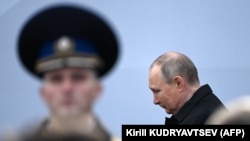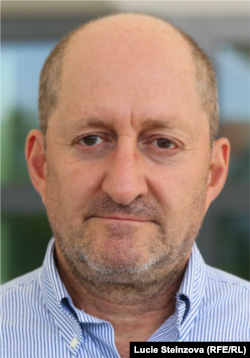NOTE TO READERS: The Week In Russia will next appear on June 3.
Like the coronavirus pandemic, Russia’s war on Ukraine is something that President Vladimir Putin cannot control – so the Kremlin is fudging the numbers and seeking to shape the narrative. Putin’s speech on the May 9 martial holiday signaled that the killing could continue for months or more.
Here are some of the key developments in Russia over the past week and some of the takeaways going forward.
'Under Control'
When the coronavirus pandemic reached Russia, it created a particularly big challenge for Putin: Could a leader more accustomed to handling the optics of relatively isolated incidents and situations created by his own choice react adequately to a major crisis that had external origins and was resistant to shaping with propaganda?
For critics of the Kremlin, the answer is "No." Weeks after Putin said in March 2020 that Russian authorities had managed “to contain the mass penetration and spread” of the virus and that the situation was “generally under control” it became clear that they had not, and that it was not.
As the enormity of the crisis set in, one big part of the Kremlin’s effort to address it was by fudging the numbers. According to the country’s coronavirus task force, fewer than 380,000 Russians have died as a result of COVID-19 since the start of the pandemic.
But in reality, the toll is widely believed to have exceeded 1 million -- out of a population of less than 150 million -- around the beginning of this year.
By contrast, the United States -- which has the highest recorded COVID death toll on the planet and a population of nearly 335 million -- passed the 1 million mark earlier this month.
Two years after the coronavirus took hold, Putin is facing another crisis that affects the entire country and defies containment, promising long-term consequences and clouding the future. This time, it’s a crisis of his own making: Russia’s unprovoked invasion of Ukraine and the war that is raging there now, killing Russian soldiers, dealing a severe blow to the country’s economy, and badly damaging its image across much of the world.
The reasons for that latter effect grow greater every day, as cities are devastated by bombs, shells, and rockets and horrific accounts of alleged atrocities emerge from areas where Russian forces have left their mark. On the Internet, for example, there’s a heartrending, heartwarming photo of a mother and her twins, survivors of a rocket attack on a train station in eastern Ukraine last month. On CNN, there’s footage of Russian soldiers talking to two apparently unarmed civilians, letting them go, and then shooting them in the back as they walk away.
On May 12, the UN Human Rights Council passed a resolution urging its investigators to examine possible abuses and violations in northern Ukraine in the weeks after the invasion began on February 24. "The scale of unlawful killings, including indications of summary executions in areas to the north of Kyiv, is shocking," UN High Commissioner for Human Rights Michelle Bachelet said.
Numbers Game
The geopolitical consequences for Russia also appear to be mounting. In his Victory Day address, Putin repeated his claim that the invasion of Ukraine was necessary to preserve the country’s security, the effect has been something else. Finland, which shares a long border with Russia, is likely to join NATO this year, and Sweden may do the same. Western sanctions are hitting the economy hard with worse expected to come, and many European countries appear determined to end their longstanding reliance on Russian oil and gas.
Meanwhile, many promising young Russians have fled the country, fearing that, at least for now, there’s nothing for them there.
And once again, one of the ways in which Putin’s government is addressing the crisis, or avoiding addressing it, is by fudging the numbers.
The last time the Defense Ministry issued an official death toll was on March 27, when it said that 1,351 Russian soldiers had been killed since Putin ordered the start of the large-scale invasion. Ukrainian and Western officials said weeks ago that the real Russian toll was more than 15,000 -- higher than the number of Soviet troops killed in Moscow’s nearly decade-long war of occupation in Afghanistan.
The apparent deception over its own casualty figures is part of a broader effort by the Russian state to keep accurate information about the war -- from the reasons it is being waged to its consequences for Russian citizens -- under wraps.
Mission Not Accomplished
The tools it is using for this effort include laws allowing criminal prosecution for disseminating what the government deems to be false information about the war and a continuing campaign of oppression against the remnants of political opposition, civil society, independent media and citizens who voice dissent.
Fudging the numbers is also part of an apparent effort to hide a particularly important piece of information about the war from Russians: How it’s going.
Putin and other officials have repeatedly said it’s going according to plan. But plenty of evidence suggests that Putin had expected the invasion to force Ukraine’s government to fold or make major concessions within a few days – and that its offensives in the east and south, where most of the fighting is now focused, are also going slower than the Kremlin would like.
The address Putin delivered at the annual military parade on Red Square on May 9, when Russia celebrates the defeat of Nazi Germany in World War II, seemed to add to that evidence.
Putin repeated groundless claims aimed at justifying the invasion of Ukraine and suggested that Russia’s military -- like the Soviet Army in what Moscow calls the Great Patriotic War -- is fighting Nazism, which is false.
He also evoked wars that Russia has been involved in going back almost a millennium, suggesting they were always defensive. But he said little or nothing concrete about Russia’s objectives in the war in Ukraine.
Some might interpret that as a crafty way to keep the world guessing, something Putin likes to do. But it seems equally plausible -- or more so -- that in the absence of the swift victory he had almost certainly expected, and in the absence of good news for Russia from the front lines, he just didn’t have much to say.
Ambitions And Limitations
For Putin, Russia analyst and author Mark Galeotti wrote, May 9 must have been marred “by the inevitable realization that what [he] had clearly once thought would be a celebration of a glorious victory, one that would fix his place in the pantheon of Russian hero-monarchs, instead had to be a foreshadowing of the greater struggles yet to come.”
“This was not the speech of a man who was contemplating retreat or even retrenchment,” Galeotti, an honorary professor at the UCL School of Slavonic and East European Studies in London, wrote in an article published in The Spectator shortly after the address. “Rather, he was signaling that the war was still to be fought.”
There were echoes of that appraisal in the testimony that U.S. Director of National Intelligence Avril Haines delivered to the Senate Armed Services Committee the following day.
"We assess President Putin is preparing for a prolonged conflict in Ukraine during which he still intends to achieve goals beyond the Donbas," Haines said -- suggesting that, at the very least, he wants Russian forces to hold parts of Ukraine they have occupied outside the Donetsk and Luhansk regions in the southeast, parts of which have been controlled by Russia-backed separatists since 2014.
A more ambitious objective that would also fall within that description would be the seizure of the port city of Odesa and a swath of southern Ukraine from the Russian border and the Donbas to Moldova, cutting Kyiv off from the Black Sea and the Sea of Azov.
But Ukrainian forces have been retaking areas that Russian forces had occupied in the east, and Haines indicated that Putin’s goals and the lack of clarity over whether they can be achieved make for a volatile mix.
The “reality” is that “Putin faces a mismatch between his ambitions and Russia's current conventional military capabilities,” she said -- and this “likely means the next few months could see us moving along a more unpredictable and potentially escalatory trajectory.”








